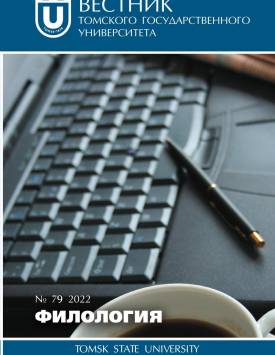On the parameters of linguoculturological commentary in the Dictionary of the Siberian Wedding Rite
The aim of this article is to determine the parameters of a linguoculturological commentary, which is a form of interpretation of lexical units in the Dictionary of the Siberian Wedding Rite created at the Russian Language Department of Tomsk State University, and on their basis to present the commenting procedure. The dictionary is made on the material of the dialects of the Middle Ob region, which objectify the traditional local culture. The key intention of the Dictionary is the most complete presentation of cultural information that is significant for the peasant community. This information is extracted from materials, converted into research component formulas based on which the commentary is built. The purpose of the commentary is to describe the word as expressing its cultural meanings based on the numerous facts of living dialect speech. To implement the idea, the lexicographic method, the method of linguoculturological commenting or interpretation were used. In the course of compiling the Dictionary, groups of vocabulary units were identified that have a typical structure in the construction of a commentary, namely, nominations: (1) items involved in the rite; (2) ritual (sacred) units proper; (3) characters participating in the wedding; (4) verbs denoting ritual actions; (5) stages of the rite. The components required for the commentary are provided by a collection of illustrative material. The research positions of the compiler of the dictionary of a linguoculturological type are as follows. (A) Any personal statement is considered as an expression of the universal attitude of the bearer of the peasant culture because it is a translation of the collective cultural codes stored in memory. (B) The illustrative part contains all the available material that formed the basis of the linguoculturological commentary. (C) Variants of statements realizing in their content the general subject of speech and having a close cultural meaning become a source of formation of a component of a linguoculturological commentary. (D) The totality of the commentary’s components, built in a typical (by belonging to a lexical group) logic of description, constitutes the content of the entire commentary. The conclusions are as follows. The genetically multicomponent essence of traditional culture and the wedding rite makes it possible to present the interpretation of the ritual lexeme as a text that is based on the hierarchy of components initially laid down in the structure of the word. A special procedure for representing the cultural connotative component of the semantics of a word is assumed. The obligatory expansion of the zone of word interpretation occurs due to information representing the originality of the peasant culture. The commentary determines the composition of the components of interpretation, isolates them from the real existence of the linguistic unit. In turn, the identified components form the basis of the commentary-word interpretation. The content of the commentary varies depending on the group of vocabulary units: each unit has a typical construction of its commentary, composed by combining research formulations based on semantic fragments arranged in accordance with Siberian ritual traditions. The presented procedure can become a universal algorithm for subsequent lexicographic research works that objectively represent the cultural semantics of the dialect lexicon. The author declares no conflicts of interests.
Keywords
dialect language, traditional culture, cultural connotation, linguoculturography, linguoculturological dictionary, parameters of linguoculturological commentary, ritual wordAuthors
| Name | Organization | |
| Bankova Tatiana B. | Tomsk State University | tatabank@mail.ru |
References

On the parameters of linguoculturological commentary in the Dictionary of the Siberian Wedding Rite | Vestnik Tomskogo gosudarstvennogo universiteta. Filologiya – Tomsk State University Journal of Philology. 2022. № 79. DOI: 10.17223/19986645/79/1
